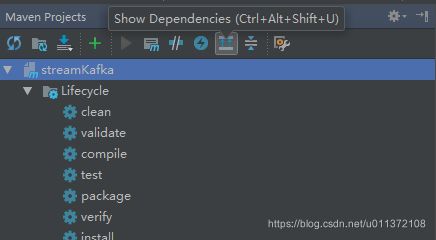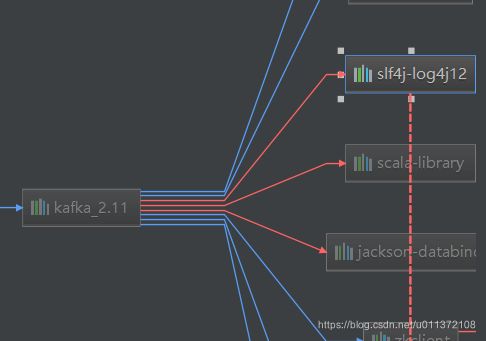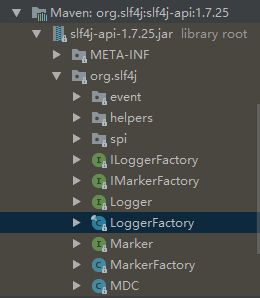log4j与logback包冲突原因及解决,不可忽视的Warning
场景
一个简单的spring-boot程序,需要用kafka做消息队列,于是在maven中引入kafka依赖,一切看似没问题,在启动时,打印出Warning信息:
SLF4J: Class path contains multiple SLF4J bindings.
SLF4J: Found binding in [jar:file:/xxx/learning-slf4j-multiple-bindings/WEB-INF/lib/logback-classic-1.2.3.jar!/org/slf4j/impl/StaticLoggerBinder.class]
SLF4J: Found binding in [jar:file:/xxx/learning-slf4j-multiple-bindings/WEB-INF/lib/slf4j-log4j12-1.7.25.jar!/org/slf4j/impl/StaticLoggerBinder.class]
SLF4J: See http://www.slf4j.org/codes.html#multiple_bindings for an explanation.
原因分析
通过警告消息,可以简单的看出是slf4j绑定发生问题,有多个StaticLoggerBinder.class存在,即slf4j-log4j12和logback-classic冲突。
-
疑惑点1是我并没有手动引入
slf4j-log4j12依赖,依赖jar包是被自动引入的,通过maven自带工具分析依赖路径,可以看出是kafka依赖于slf4j-log4j12,自动导入的依赖包。


-
日志绑定的机制分析
从日志对象开始探究slf4j的绑定方式。
import org.slf4j.Logger;
import org.slf4j.LoggerFactory;
···
private final Logger logs = LoggerFactory.getLogger(***.class);
LoggerFactory.getLogger()方法:(下述均只保留关键逻辑代码 )
public static Logger getLogger(Class<?> clazz) {
Logger logger = getLogger(clazz.getName());
···
return logger;
}
public static Logger getLogger(String name) {
ILoggerFactory iLoggerFactory = getILoggerFactory();//看这里
return iLoggerFactory.getLogger(name);//根据名字返回一个Logger实例对象
}
ILoggerFactory是一个接口,归属package org.slf4j;仅存在一个方法为:
public Logger getLogger(String name);
接下来就是看看getILoggerFactory()的真面目:
public static ILoggerFactory getILoggerFactory() {
if (INITIALIZATION_STATE == UNINITIALIZED) {
synchronized (LoggerFactory.class) {
if (INITIALIZATION_STATE == UNINITIALIZED) {
INITIALIZATION_STATE = ONGOING_INITIALIZATION;
performInitialization();//看这里
}
}
}
switch (INITIALIZATION_STATE) {
case SUCCESSFUL_INITIALIZATION:
return StaticLoggerBinder.getSingleton().getLoggerFactory();
case NOP_FALLBACK_INITIALIZATION:
return NOP_FALLBACK_FACTORY;
case FAILED_INITIALIZATION:
throw new IllegalStateException(UNSUCCESSFUL_INIT_MSG);
case ONGOING_INITIALIZATION:
// support re-entrant behavior.
// See also http://jira.qos.ch/browse/SLF4J-97
return SUBST_FACTORY;
}
throw new IllegalStateException("Unreachable code");
}
可以看到performInitialization()是进行初始化的方法:
private final static void performInitialization() {
bind();
···
}
performInitialization()内部调用bind()方法:
private final static void bind() {
try {
Set<URL> staticLoggerBinderPathSet = null;
if (!isAndroid()) {
staticLoggerBinderPathSet = findPossibleStaticLoggerBinderPathSet();//看这里
reportMultipleBindingAmbiguity(staticLoggerBinderPathSet);
}
// the next line does the binding
StaticLoggerBinder.getSingleton();
INITIALIZATION_STATE = SUCCESSFUL_INITIALIZATION;
reportActualBinding(staticLoggerBinderPathSet);
fixSubstituteLoggers();
replayEvents();
// release all resources in SUBST_FACTORY
SUBST_FACTORY.clear();
} catch (NoClassDefFoundError ncde) {...
} catch (java.lang.NoSuchMethodError nsme) {...
} catch (Exception e) {...}
}
其中关键在于findPossibleStaticLoggerBinderPathSet()方法,终于到了查找绑定相关的部分内容,可以看到是查找所有的"org/slf4j/impl/StaticLoggerBinder.class"类并加载,同时while循环里,将可能存在的多个StaticLoggerBinder.class路径均加入Set返回。
private static String STATIC_LOGGER_BINDER_PATH = "org/slf4j/impl/StaticLoggerBinder.class";
static Set<URL> findPossibleStaticLoggerBinderPathSet() {
Set<URL> staticLoggerBinderPathSet = new LinkedHashSet<URL>();
try {
ClassLoader loggerFactoryClassLoader = LoggerFactory.class.getClassLoader();
Enumeration<URL> paths;
if (loggerFactoryClassLoader == null) {//看这里
paths = ClassLoader.getSystemResources(STATIC_LOGGER_BINDER_PATH);
} else {
paths = loggerFactoryClassLoader.getResources(STATIC_LOGGER_BINDER_PATH);
}
while (paths.hasMoreElements()) {//看这里
URL path = paths.nextElement();
staticLoggerBinderPathSet.add(path);
}
} catch (IOException ioe) {
Util.report("Error getting resources from path", ioe);
}
return staticLoggerBinderPathSet;
}
返回到bind()方法中:
private final static void bind() {
···
staticLoggerBinderPathSet = findPossibleStaticLoggerBinderPathSet();
reportMultipleBindingAmbiguity(staticLoggerBinderPathSet);//看这里
···
}
···
private static void reportMultipleBindingAmbiguity(Set<URL> binderPathSet) {
if (isAmbiguousStaticLoggerBinderPathSet(binderPathSet)) {
Util.report("Class path contains multiple SLF4J bindings.");
for (URL path : binderPathSet) {
Util.report("Found binding in [" + path + "]");
}
Util.report("See " + MULTIPLE_BINDINGS_URL + " for an explanation.");
}
}
这里可以看到reportMultipleBindingAmbiguity()里判断是否发生多重绑定,就是打印文章开头Warning信息的地方。
成功加载StaticLoggerBinder后,在bind()方法中调用其getSingleton()方法得到单例,并修改INITIALIZATION_STATE状态,至此完成日志框架的绑定。
private final static void bind() {
if (!isAndroid()) {
staticLoggerBinderPathSet = findPossibleStaticLoggerBinderPathSet();
reportMultipleBindingAmbiguity(staticLoggerBinderPathSet);
}
StaticLoggerBinder.getSingleton();//看这里
INITIALIZATION_STATE = SUCCESSFUL_INITIALIZATION;
reportActualBinding(staticLoggerBinderPathSet);
···
}
最后附上slf4j-api-1.7.25.jar和logback-classic-1.2.3.jar的目录结构供参考:


解决方案
分析了原因,那么解决方案自然很简单,就是剔除不需要的依赖包,此处就是在kafka的依赖中剔除slf4j-log4j12。maven项目中可以通过exclusions标签来完成。
<dependency>
<groupId>org.apache.kafkagroupId>
<artifactId>kafka_2.11artifactId>
<version>0.10.0.1version>
<exclusions>
<exclusion>
<groupId>org.slf4jgroupId>
<artifactId>slf4j-log4j12artifactId>
exclusion>
exclusions>
dependency>
本文就简单分析了日志加载绑定的过程,如有遗漏请不吝指出。